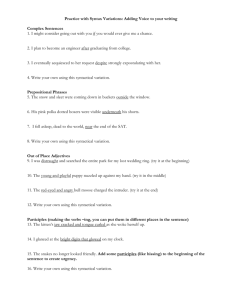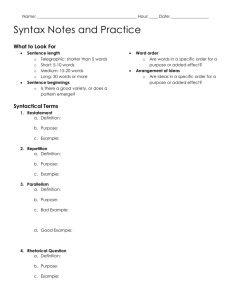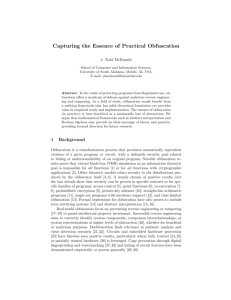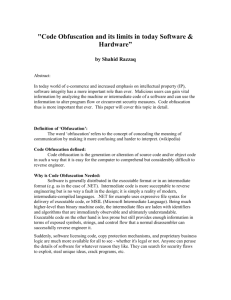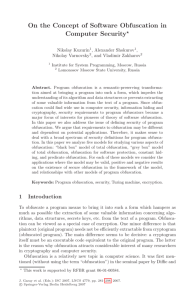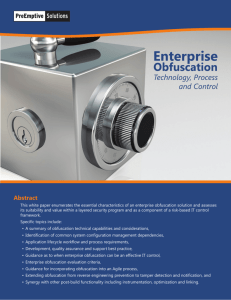Software Protection with Increased Complexity and
advertisement
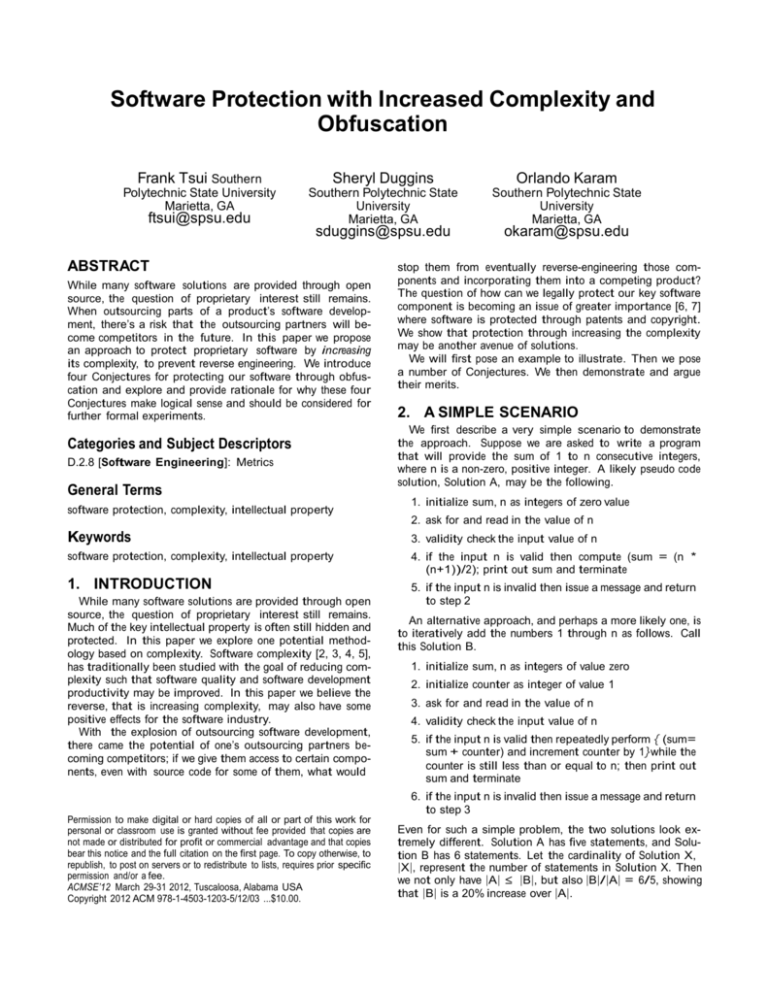
Software Protection with Increased Complexity and
Obfuscation
Frank Tsui Southern
Polytechnic State University
Marietta, GA
ftsui@spsu.edu
Sheryl Duggins
Orlando Karam
Southern Polytechnic State
University
Marietta, GA
Southern Polytechnic State
University
Marietta, GA
sduggins@spsu.edu
ABSTRACT
While many software solutions are provided through open
source, the question of proprietary interest still remains.
When outsourcing parts of a product’s software development, there’s a risk that the outsourcing partners will become competitors in the future. In this paper we propose
an approach to protect proprietary software by increasing
its complexity, to prevent reverse engineering. We introduce
four Conjectures for protecting our software through obfuscation and explore and provide rationale for why these four
Conjectures make logical sense and should be considered for
further formal experiments.
Categories and Subject Descriptors
D.2.8 [Software Engineering]: Metrics
General Terms
software protection, complexity, intellectual property
okaram@spsu.edu
stop them from eventually reverse-engineering those components and incorporating them into a competing product?
The question of how can we legally protect our key software
component is becoming an issue of greater importance [6, 7]
where software is protected through patents and copyright.
We show that protection through increasing the complexity
may be another avenue of solutions.
We will first pose an example to illustrate. Then we pose
a number of Conjectures. We then demonstrate and argue
their merits.
2. A SIMPLE SCENARIO
We first describe a very simple scenario to demonstrate
the approach. Suppose we are asked to write a program
that will provide the sum of 1 to n consecutive integers,
where n is a non-zero, positive integer. A likely pseudo code
solution, Solution A, may be the following.
1. initialize sum, n as integers of zero value
2. ask for and read in the value of n
Keywords
3. validity check the input value of n
software protection, complexity, intellectual property
4. if the input n is valid then compute (sum = (n *
(n+1))/2); print out sum and terminate
1. INTRODUCTION
5. if the input n is invalid then issue a message and return
to step 2
While many software solutions are provided through open
source, the question of proprietary interest still remains.
Much of the key intellectual property is often still hidden and
protected. In this paper we explore one potential methodology based on complexity. Software complexity [2, 3, 4, 5],
has traditionally been studied with the goal of reducing complexity such that software quality and software development
productivity may be improved. In this paper we believe the
reverse, that is increasing complexity, may also have some
positive effects for the software industry.
With the explosion of outsourcing software development,
there came the potential of one’s outsourcing partners becoming competitors; if we give them access to certain components, even with source code for some of them, what would
An alternative approach, and perhaps a more likely one, is
to iteratively add the numbers 1 through n as follows. Call
this Solution B.
1. initialize sum, n as integers of value zero
2. initialize counter as integer of value 1
3. ask for and read in the value of n
4. validity check the input value of n
5. if the input n is valid then repeatedly perform { (sum=
sum + counter) and increment counter by 1}while the
counter is still less than or equal to n; then print out
sum and terminate
6. if the input n is invalid then issue a message and return
to step 3
Permission to make digital or hard copies of all or part of this work for
personal or classroom use is granted without fee provided that copies are
not made or distributed for profit or commercial advantage and that copies
bear this notice and the full citation on the first page. To copy otherwise, to
republish, to post on servers or to redistribute to lists, requires prior specific
permission and/or a fee.
ACMSE’12 March 29-31 2012, Tuscaloosa, Alabama USA
Copyright 2012 ACM 978-1-4503-1203-5/12/03 ...$10.00.
Even for such a simple problem, the two solutions look extremely different. Solution A has five statements, and Solution B has 6 statements. Let the cardinality of Solution X,
|X|, represent the number of statements in Solution X. Then
we not only have |A| ≤ |B|, but also |B|/|A| = 6/5, showing
that |B| is a 20% increase over |A|.
If the cardinality of solution, |Z|, is x, then adding one
more statement to the solution to get |Z | = x + 1 would
increases the permutations by a factor of x+1. Adding two
more statements would increase the permutations
by a factor
of (x + 1) ∗ (x + 2) or an order of x2 .
In terms of these syntactical measurements, cardinality of
solution and number of different computational task types,
Solution B’s source statements, as represented with the pseudocode, will be considered more complex. If more complex
implies its intention is less likely to be discovered, then one
might believe that Solution B is the better solution. Thus
Solution B may be thought, by some, as more protective of
the intent of the solution than Solution A.
Now, let’s review what a perpetrator may do to ascertain the intent of these two solutions. One obvious and
commonly used procedure is to observe the behavior of the
two solutions by feeding different inputs to the solutions,
similar to black-box testing approach. Then both solutions
will behave alike in terms of what they output. Since both
solutions will behave alike with the same inputs, one may
conclude that the intent of both solutions will either never
be cracked or cracked simultaneously. Under such black-box
analysis, the effort required to discover the intent behind the
two solutions will essentially be equal.
Consider the scenario where the source code or the pseudo
code became available. Then would there be a difference in
the effort expended for the discovery? According to the earlier syntactical analysis, Solution B should be more difficult,
or take more effort, to analyze. On the other hand, if one
is not familiar with the term (n*(n+1))/2, then statement 4
in Solution A may present quite a challenge. We also note
that the variable name, sum, may be a give-away. This purposeful re-naming of a variable further from its contextual
intent may make statement 4 in Solution A even more difficult to analyze. The degree of confusion introduced by this
purposeful renaming in statement 5 of solution B may not
be as much as that in Solution A. But it opens a window
into what semantics behind the syntax may bring.
We have presented several Conjectures with this simple
example, and they are summarized below.
1. Cardinality of solution, in terms of number of statements should make a difference in the effort required
to discover the real solution.
2. Syntactical complexity, measured by some volume of
syntax whether it is cardinality of solution or number
of different operational types, should contribute to the
effort needed for discovery of the solution intent or
purpose.
3. Unfamiliar intention behind a simple syntactical term
such as ((n * (n+1)) /2) may be a deterrent to discovery of solution intent.
4. Picking syntactical terms, such as “degree” as opposed
to “sum”, which have less affinity to the real, semantic
intent also contributes as a deterrent to discovery of
real intent.
3. SYNTACTICAL AND SEMANTIC ANALYSIS
Conjectures (1), (2), and (4) all deal with syntactical obfuscation. Conjecture (3), however, is related to semantics
and intentions. We know from complexity studies and previous syntactical obfuscation [1], that adding more terms
or introducing misleading terms increases complexity, thus
more obfuscation. But the more difficult one to analyze is
the intention of statement 4 of solution A, if one is not familiar with the mathematics. Thus the interpretation function
requires both the semantics of the syntactical terms and the
“math” background to properly map to the intention as follows:
Interpretation (semantics, background) -> Intention
Our early, informal tests have been encouraging, and we are
planning to conduct a more formal experiment on obfuscation.
4. INFORMAL SAMPLING AND CONCLUSION
We presented both versions of the code to a small sample
of computer science undergraduate students. The informal
results were encouraging and we plan to experiment further.
Software complexity study and the desire to simplify software originated from the needs of reducing development effort and reducing error and defect rates in software. In this
paper we explored the reverse; we looked at introducing complexity and the potential leveraging of complexity to protect
our intellectual property. Four Conjectures for protecting
our software through obfuscation were introduced. We explored and provided rationale of why these four Conjectures
make logical sense and should be considered for further formal experiments. We believe that complexity, when properly used, may be considered a positive tool, besides the legal
channels, for protecting our software intellectual property.
5. REFERENCES
[1] C. Collberg, J. Davidson, R. Giacobazzi, Y. X. Gu,
A. Herzberg, and F. Wang. Toward digital asset
protection. IEEE Intelligent Systems,
November/December 2011.
[2] M. H. Halstead. Elements of Software Science. Elsevier,
1977.
[3] T. McCabe. A complexity measure. IEEE Transactions
on Software Engineering, 2(4), December 1976.
[4] R. Subramanyan and M. Krishnan. Empirical analysis of
ck metrics for object-oriented design complexity:
Implications for software defects. IEEE Transactions on
Software Engineering, 29(4), April 2003.
[5] F. Tsui, O.Karam, S. Duggins, and C. Bonja. On
inter-method and intra-method object-otiented class
cohesion. International Journal of Information
Technologies and System Approach, 2(1), June 2009.
[6] U.S. Department of Justice. Report of the department
of justice’s task force on intellectual property. Accessed
2012, October 2004.
[7] M. Webbink. A new paradigm for intellectual property
rights in software. Duke Law & Technology Review,
May 2005.
